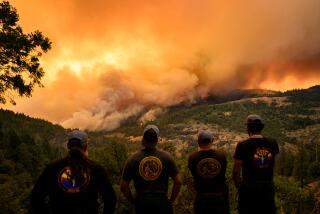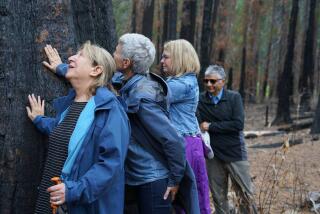Biologists Worry About Sage Grouse After Fire at Washington Reserve
YAKIMA, Wash. — Biologists are trying to determine what effect the Hanford nuclear reservation fire had on habitat for the northwestern sage grouse, a bird being considered for federal protection.
“One of the best habitats for sage grouse is the area that has been burned,” Randi Thompson, a spokeswoman for the U.S. Fish and Wildlife Service, said Friday.
In addition to being considered for protection under the Endangered Species Act, the bird is on the Audubon Society’s Blue List as a species of special concern in Oregon, Washington and parts of Canada.
It’s undetermined how many of the grouse actually live on the Arid Lands Ecology Reserve, which is part of the 560-square-mile Hanford reservation in south-central Washington.
There were documented sightings last year, the first in a decade or more, said Jeff Haas, deputy director for the reserve, which is managed by the Fish and Wildlife Service. The population there may be just four to six birds.
“I don’t think that sage grouse would get burned up in the fire. They may have abandoned the area somewhat--possibly temporarily or long term,” Haas said.
The 191,000-acre blaze, sparked by a fatal traffic collision, burned across nearly half of the reservation last week and destroyed 11 homes outside the southern boundary.
The Army’s nearby Yakima Training Center is one of the strongholds for the grouse in Washington, despite regular fires there, Haas said.
“Some prime . . . sagebrush habitat was burned in the fire. How that will affect sage grouse, I don’t know,” Haas said.
The Clinton administration a few weeks ago designated the Hanford Reach on the Columbia River and 200,000 acres around it as a national monument.
“There’s a lot of other habitat remaining within the monument that is likely to be used by sage grouse,” Haas said, including some land contiguous to the training center that provides a corridor for the birds.
The Interior Department’s Burnt Area Emergency Rehabilitation Team is surveying Hanford for damage, including the 77,000 acres that burned on the reserve.
The Fish and Wildlife Service has 80,000 sage plants grown from native seed that can be replanted at Hanford. Sage grouse eat and nest in sagebrush.
The 700 to 800 elk that roam the reserve have been spotted elsewhere, searching for food. Wildlife agents suggest that drivers in the area take extra care and keep an eye out for elk on the roads.
Two elk were killed Tuesday when they were hit by a tractor-trailer rig on Washington 240 near Horn Rapids.
More to Read
Sign up for Essential California
The most important California stories and recommendations in your inbox every morning.
You may occasionally receive promotional content from the Los Angeles Times.










